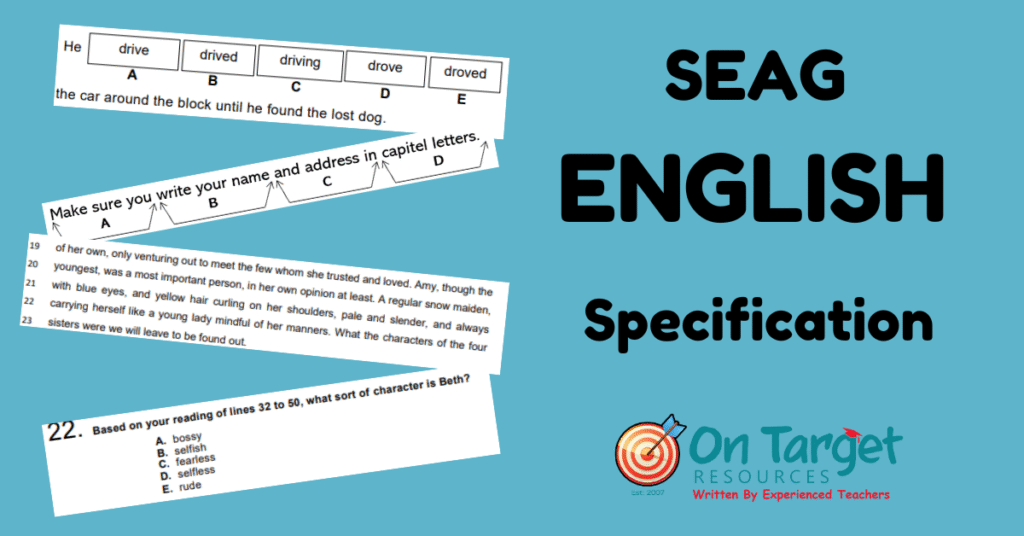SEAG English Exam Specification: A Guide for Parents
If your child is getting ready for SEAG Transfer Test in Northern Ireland, here’s everything you need to know about the English exam specification—minus the jargon and stress!

What’s Being Tested in the SEAG English Exam?
This English test is all about Reading and a little bit of Writing, but don’t worry—there’s no essay writing or handwriting judging here!
The exam checks two main things:
- Reading Skills – Can your child understand what they’re reading? Can they pick up on what the writer is saying, how they’re saying it, and why?
- Writing Know-How – Can they spot correct spelling, punctuation, and grammar? Think of it as editing rather than writing!
What Will They Be Asked to Do?
Your child will:
- Read a variety of texts—stories, information pieces, and maybe even a poem or two.
- Show that they understand what they’ve read by answering questions. Sometimes, they’ll need to read between the lines (hello, inference and deduction!).
- Spot how language can be used to grab a reader’s attention or get a message across.
- Use clever strategies to figure out unfamiliar words.
- Recognise different text types (like letters, ads, or instructions) and know what they’re for.
- Prove they can spell well and use punctuation and grammar to make sense—think commas, capitals, and correct word choices.
SEAG Reading Comprehension
Your child will be asked to read different types of texts—including prose, poetry, fiction, and non-fiction—and show that they can:
- Find and use information from a passage
- Understand literal meaning (what it says) and infer meaning (what it suggests)
- Recognise styles like rhyme, verse, dialect, and wordplay
- Identify the purpose of a piece of writing (to inform, entertain, persuade, etc.)
- Understand how language affects the reader—does it grab your attention or create emotion?
SEAG Spelling & Punctuation
Your child will use proofreading skills to spot mistakes and demonstrate their knowledge of:
- UK English spellings (e.g. “colour,” not “color”)
- Common spelling rules, irregular spellings, and tricky homophones like:
- their/there/they’re
- wear/where/were
- him/hymn
- Punctuation marks, including:
- Capital letters, commas, full stops
- Colons, semi-colons, apostrophes
- Speech and quotation marks
- Question/exclamation marks, brackets, hyphens
They’ll also be familiar with text features like indexes, glossaries, contents pages, and the difference between fiction and non-fiction.
SEAG Grammar and Syntax
Expect questions on:
- Parts of speech (noun, verb, adjective, adverb, conjunction, preposition, pronoun)
- Verb tenses, especially:
- Present and past (including irregular verbs like seek/sought, go/went)
- Future and conditional (will/would)
- Abbreviated tenses like they’re, would’ve, could’ve
- Plural forms, including irregular plurals (like oxen)
- Comparative and superlative forms (e.g. bigger, biggest)
- Understanding how words form phrases, sentences, paragraphs, and chapters
SEAG Vocabulary Skills
To show vocabulary knowledge, your child will need to:
- Understand the meaning of words used in the texts
- Recognise synonyms (words with similar meanings)
- Spot homonyms and homophones in everyday use
What the SEAG English Exam Doesn’t Include
Here’s what won’t be tested:
- ❌ No long-form writing or essays
- ❌ No tricky tenses like future perfect
- ❌ No creative writing tasks
Most answers will be just a few words long. The focus is entirely on understanding, spotting correct (or incorrect) use of English, and interpreting texts.
How Can Parents Help with the SEAG English Exam?
- Read a wide range of texts with your child—stories, articles, poems, even song lyrics!
- Discuss tricky words and talk about how writers use language to make a point
- Practice spotting spelling and punctuation errors together
- Use flashcards or apps for parts of speech and verb tenses
- Use On Target English Revision Books to practise key elements of the SEAG exam.
- Keep it light and fun—confidence is key!
Final Thoughts
The SEAG English Exam isn’t about fancy vocabulary or perfect handwriting—it’s about solid reading skills, grammar know-how, and the ability to understand and explain what’s going on in a piece of writing. With a little support at home, school or with a tutor, your child will be more than ready to shine.
Find out more about the SEAG exam in Northern Ireland on the SEAG Website.
How On Target Resources Can Help You Prepare for the SEAG English Exam?
Preparing for the SEAG English Exam doesn’t have to be overwhelming. At On Target Resources, we’re here to make the process smoother, smarter, and more effective—for both you and your child.
We offer a range of resources designed specifically for SEAG preparation, including:
✅ High-quality Practice Papers – Just like the real thing, so your child knows exactly what to expect
✅ Targeted Revision Books – Clear explanations and practice questions tailored to the SEAG English specification
✅ Fun Online Quizzes – Great for reinforcing grammar, punctuation, vocabulary and comprehension—in short, focused bursts
Whether your child needs to build confidence in comprehension or brush up on their grammar skills, our resources are designed to support them every step of the way.
📚 Explore our full range at ontargetresources.co.uk
Give your child the tools they need to succeed—and feel ready, not rushed, on exam day!
